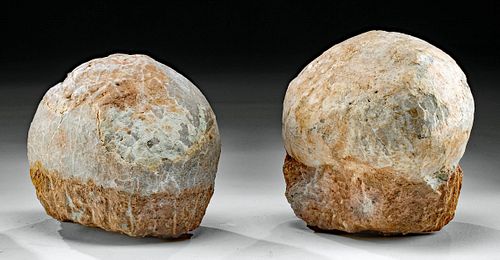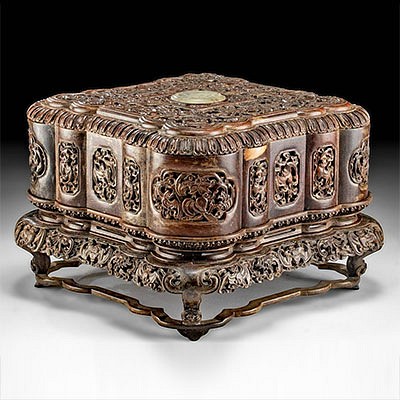Pair of Fossilized Hadrosauridae Dinosaur Eggs
Lot 67
About Seller
Artemis Gallery
686 S Taylor Ave, Ste 106
Louisville, CO 80027
United States
Selling antiquities, ancient and ethnographic art online since 1993, Artemis Gallery specializes in Classical Antiquities (Egyptian, Greek, Roman, Near Eastern), Asian, Pre-Columbian, African / Tribal / Oceanographic art. Our extensive inventory includes pottery, stone, metal, wood, glass and textil...Read more
Categories
Estimate:
$1,600 - $2,500
Absentee vs Live bid
Two ways to bid:
- Leave a max absentee bid and the platform will bid on your behalf up to your maximum bid during the live auction.
- Bid live during the auction and your bids will be submitted real-time to the auctioneer.
Bid Increments
| Price | Bid Increment |
|---|---|
| $0 | $25 |
| $300 | $50 |
| $1,000 | $100 |
| $2,000 | $250 |
| $5,000 | $500 |
| $10,000 | $1,000 |
| $20,000 | $2,500 |
| $50,000 | $5,000 |
| $100,000 | $10,000 |
| $200,000 | $20,000 |
About Auction
By Artemis Gallery
Apr 8, 2021
Set Reminder
2021-04-08 10:00:00
2021-04-08 10:00:00
America/New_York
Bidsquare
Bidsquare : Fine Antiquities | Asian | Ethnographic Art
https://www.bidsquare.com/auctions/artemis-gallery/fine-antiquities-asian-ethnographic-art-6770
Features classical antiquities, ancient and ethnographic art from cultures encompassing the globe. Egyptian, Greek, Roman, Etruscan, Near Eastern, Asian, Pre-Columbian, Native American, African / Tribal, Oceanic, Spanish Colonial, Russian, Fine Art, so much more! All legally acquired, legal to sell. Artemis Gallery info@artemisgallery.com
Features classical antiquities, ancient and ethnographic art from cultures encompassing the globe. Egyptian, Greek, Roman, Etruscan, Near Eastern, Asian, Pre-Columbian, Native American, African / Tribal, Oceanic, Spanish Colonial, Russian, Fine Art, so much more! All legally acquired, legal to sell. Artemis Gallery info@artemisgallery.com
- Lot Description
Eastern Asia, China, Henan Province, late Cretaceous, ca. 100 to 65 million years ago. Two well-preserved fossilized dinosaur eggs from the hadrosauridae family. The eggshell surface and ovoid shape are nicely preserved on both, with a slightly cracked texture that results from the fossilization process. The stone sediment they were discovered in has been partially preserved on the bottoms to provide a natural support for the eggs. Hadrosaurids are also known as duck-billed dinosaurs, since they had broad, flattened snouts that looked like beaks. These herbivores had grinding teeth for vegetation. With a heat lamp and a nest box, perhaps you will get these baby dinosaurs to hatch? Wishful thinking! Size of larger egg: 6" L x 4.5" W x 5.5" H (15.2 cm x 11.4 cm x 14 cm) Size: 6" L x 4.5" W x 5.5" H (15.2 cm x 11.4 cm x 14 cm)
In the past few decades, paleontological research in China has rewritten our knowledge of dinosaurs, especially the later Cretaceous period, which was previously known mainly from western North America. Incredible finds of fossilized skeletal remains, eggs, nests, footprints, and related non-dinosaur animals and plants have given us a new understanding of how dinosaurs lived - and how they parented. Scholars posit that these animals were devoted parents, nurturing their children from eggs through childhood and living in family units.
Provenance: private Evergreen, Colorado, USA collection; ex-private Denver, Colorado, USA, collection, acquired 1960 to 2000
All items legal to buy/sell under U.S. Statute covering cultural patrimony Code 2600, CHAPTER 14, and are guaranteed to be as described or your money back.
A Certificate of Authenticity will accompany all winning bids.
We ship worldwide and handle all shipping in-house for your convenience.
#163127Stable cracks and fissures on both from fossilization process. Nicks and chips. Small areas of loss on larger egg. Light mineral deposits on both, and stone matrix preserved on bottom for stability.Condition
- Shipping Info
-
All shipping is handled in-house for your convenience. Your invoice from Artemis Gallery will include shipping calculation instructions. If in doubt, please inquire BEFORE bidding for estimated shipping costs for individual items.
-
- Buyer's Premium



 EUR
EUR CAD
CAD AUD
AUD GBP
GBP MXN
MXN HKD
HKD CNY
CNY MYR
MYR SEK
SEK SGD
SGD CHF
CHF THB
THB













